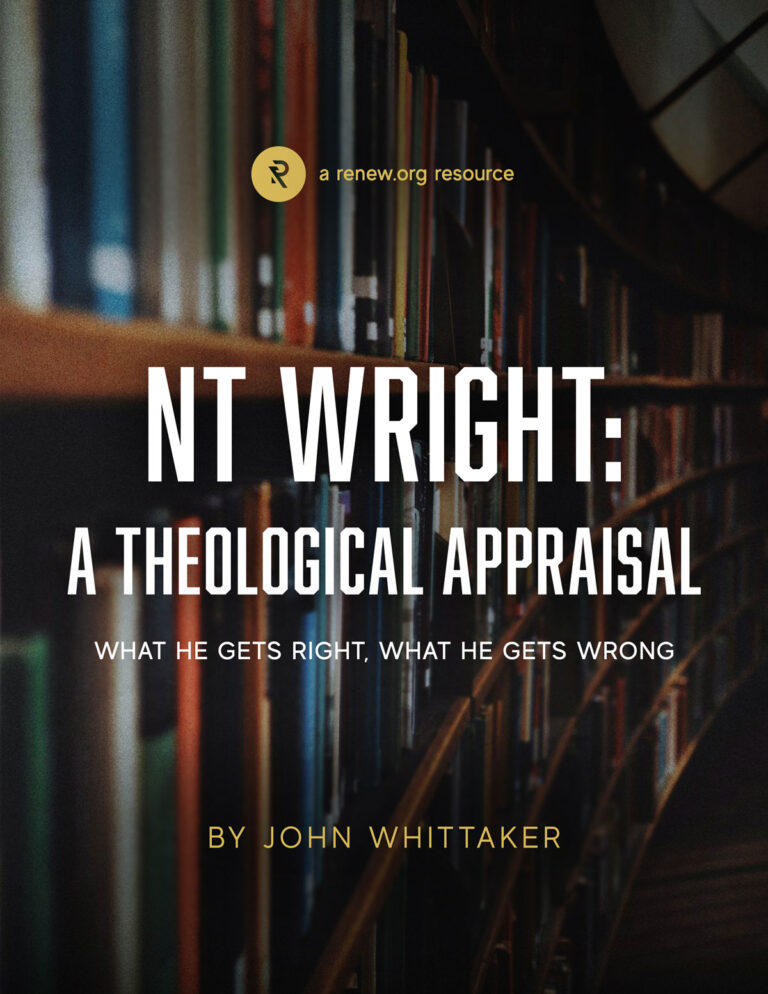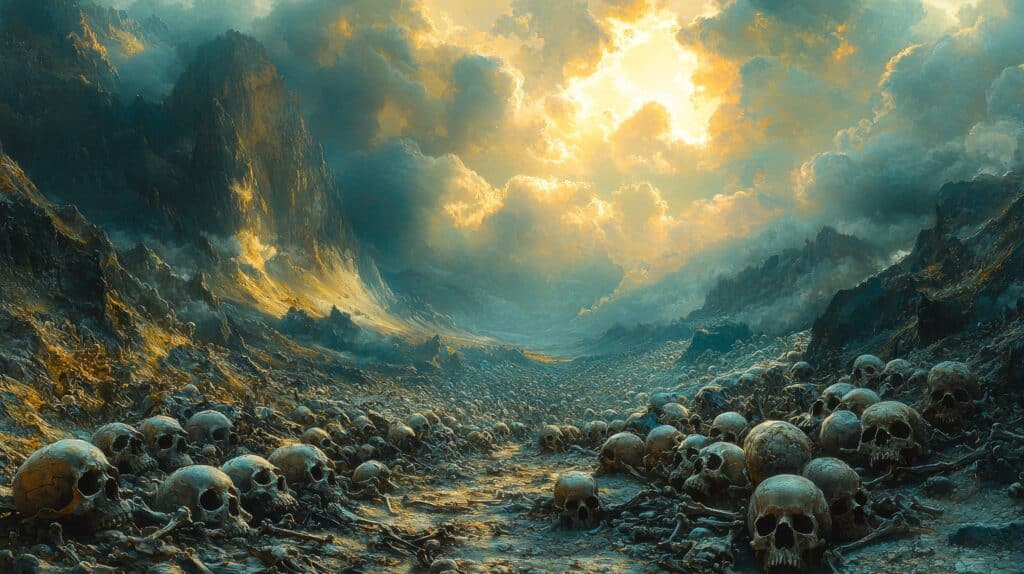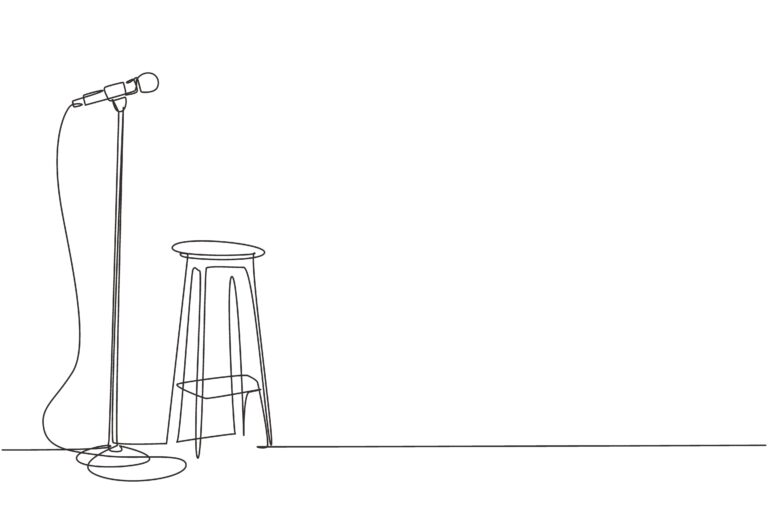The book of Ezekiel is titled after the name of the prophet Ezekiel, son of Buzi who was among the exiles of Babylon. What do we know about this unusual book of prophetic signs and oracles? In this summary article, we’ll look at major questions regarding the book of Ezekiel, including its author, date, canonicity, and overview.
Author of Ezekiel
Since most of Ezekiel (other than 1:2-3) is in the first person, one would expect the assumption to be that Ezekiel is the author. However, Jewish tradition in the Babylonian Talmud held that the Great Synagogue led by Ezra was the compiler of the book, about a hundred years after Ezekiel’s time.
Even if compiled by later scribes, it was assumed that the book’s teachings could be traced back to a prophet named Ezekiel. That is, until liberal scholarship of the late 19th and early 20th centuries tried to divide the book up only leaving a few verses to a historical Ezekiel. However, Ezekiel shows an exceptional literary unity that even liberals recognize, and so most suggest an author that, if not Ezekiel, was at least close to Ezekiel’s time. There is no real reason why Ezekiel could not have been the author.
Date of Ezekiel
Ezekiel is full of dates. After the book of Haggai, Ezekiel is the most precisely dated book in Scripture. Ezekiel’s call comes in 593 B.C. in the 5th year of the exile of King Jehoiachin, and the final oracle in the book would be in about April 571 B.C. This gives a ministry of at least 22 years, though it is certainly possible that Ezekiel may have ministered longer than that.
“After the book of Haggai, Ezekiel is the most precisely dated book in Scripture.”
Canonicity of Ezekiel
Ezekiel is one of the Major Prophets in the English classification system and is a latter prophet in the Hebrew classification system. There does seem to have been some debate on whether or not the book should be included in the canon, mostly due to differences between the Law of Moses and the New Temple vision in Ezekiel 40-48. One scholar, Hananiah ben Hezekiah, is said to have gone through 300 barrels of oil reconciling the two. His work is lost, but it might have had a profound impact on Ezekiel remaining in the canon. Apocryphal works like Ecclesiasticus and the Jewish historian Josephus both seem to include Ezekiel within their lists of the Hebrew canon.
Text of Ezekiel
Ezekiel comes to us with a bit of a challenging textual tradition. The Old Greek version of the Septuagint has Ezekiel being about one eighth shorter than the Hebrew version. One early Old Greek version called Papyrus 967 has chapters in a different order with the order being 36, 38, 39, 37, 40-48. In addition, Josephus makes a startling claim that Ezekiel wrote two books. Some have interpreted this as chapters 1-39 being one book and then chapters 40-48 being another book. Others have pointed to the pseudepigraphal Ezekiel Apocryphon as being the other book.
“Josephus makes a startling claim that Ezekiel wrote two books.”
Outline of Ezekiel
Ezekiel can be outlined a few different ways. Most view the first 24 chapters as a literary unit full of sign acts and oracles about the coming fall of Jerusalem. Chapters 25-32 focus on the fates of foreign nations. Chapter 33 is a literary bridge between everything that has come before with chapters 34-48. The final chapters 34-48 cover a variety of themes, whether judgment on Edom, a resurrection of national Israel, the defeat of Gog and Magog, or the new Temple. What each of these themes have in common is that they are all meant to be comfort for Israel.
Overview of Ezekiel
Chapters 1-3
The first three chapters contain one of the most stunning visions in Scripture, known as the Merkabah or “chariot-throne” vision. Ezekiel is with the exiles by the River Chebar when the heavens open and a chariot throne descends. Carrying the throne are four living creatures with four wings and four faces (Man, Ox, Eagle, Lion) with four wheels within wheels that have eyes all around. These beings are referred to as cherubim (the four living elders in Revelation have a similar description). These beings bear a throne upon which sits the LORD, who is pictured like burning fire and glowing metal.
Amid this vision, God calls Ezekiel (“God strengthens”) to be a prophet to the stiff-necked house of Israel in exile. This is about seven years before the final fall of Jerusalem. Ezekiel will be given a scroll of the words of the LORD to eat so that the word of God would be in him. He then is silent for a full week. Some commentators suggest that Ezekiel would basically be mute for seven years (a “week”), save when receiving a message from the LORD, until he gets news of Jerusalem’s fall in Chapter 33. That would explain why, from chapters 4-32, Ezekiel is acting out some of his famous “sign-acts.”
“Ezekiel is with the exiles by the River Chebar when the heavens open and a chariot throne descends.”
Chapters 4-12
Chapter 4 has Ezekiel inscribing Jerusalem on a brick and play-acting laying siege to it. He then has to lie on his side 390 days for the sins of Israel and 40 for the sins of Judah (390+40 =430, the length of the captivity in Egypt) and eat bread made of a variety of different grains and legumes (the bread of a famine). In chapter 5, we see another “sign-act” in which Ezekiel will cut his hair and divide it into 3 portions each symbolizing what will happen to 1/3 of the population of Jerusalem. An important detail is that a few hairs are saved, which symbolize a remnant that would survive the devastation. Chapters 6 and 7 are oracles against the cities and the mountains of Judah.
Chapters 8-11 clue the reader in on the depravity of the city of Jerusalem by going into Temple and seeing four abominations that are desecrating the Temple. These four abominations are an idol of jealousy, people worshiping images on a wall, women weeping for the Babylonian deity Tammuz, and elders of Jerusalem bowing down and worshipping the sun while turning their back on the Temple. God’s presence will leave the temple and take up residence on the Mount of Olives east of the city. In this vision, God sends an angelic messenger throughout the city setting apart those who hadn’t worshipped idols to be spared. God then sends the destroying angels to wipe out the idolaters. In chapter 12, we have one more “sign-act” in which Ezekiel will pack a bag, dig through a wall, and go into exile.
Chapters 13-24
Chapter 13 includes some warnings about false prophets and women who are dabbling in magic. We see a bit of interaction with the elders of the people in exile in chapter 14, but although they come to Ezekiel, their hearts are not right. They want to know about the fate of Jerusalem (it had not yet fallen at this point), but Ezekiel tells them that even if Noah, Job, and Daniel were present in the city, it would still fall. Chapter 15 has a parable of a vine, in which Jerusalem is compared to vine wood which is only good for burning.
Chapter 16 (along with chapter 23) is one of the more graphic chapters in all of Scripture. It describes a foundling little girl abandoned by all others, but the LORD takes pity on her and raises her up. This little girl is the house of Israel. When she gets of age, the LORD marries her (i.e., enters into covenant with her), but she plays the harlot with a variety of lovers, and so she will be punished as an adulterous woman.
Chapter 17 is the parable concerning the two eagles (symbolizing Babylon and Egypt) and the low spreading vine (likely Zedekiah, king of Judah) who betrays the first eagle to go after the second and is destroyed. Chapter 18 has interesting significance in that it speaks to the issue of whether the people of Jerusalem were paying the price for their fathers’ sins. The reality is that each generation is responsible for their own crimes and Jerusalem’s punishment is just.
“The reality is that each generation is responsible for their own crimes and Jerusalem’s punishment is just.”
Chapter 19 is a lament over the fate of the last kings of Judah, pictured as lions who are ultimately captured. Chapter 20 is a history lesson of Israel’s consistent behavior of disobedience. Chapter 21 tells of King Nebuchadnezzar’s approach to Jerusalem during its last years and how the “divinations” that he chose to use all pointed him to Jerusalem (the alternative was Rabbah of the Ammonites).
Moving to chapter 23 we get another graphic parable, this time of two sisters, Oholah and Oholibah, who are very promiscuous even though they were married to the LORD. The LORD removes Oholah (Israel) for her sin first, and Oholibah (Judah) sees this, but instead of taking warning, she acts even more wickedly, and so her judgment is certain.
Chapter 24 records perhaps one of the most difficult things a prophet to had to endure. He is told that his wife will die within a day and in the midst of that day, instead of being with her, Ezekiel is commanded to speak to the people. His wife dies and Ezekiel is forbidden to mourn. Ezekiel is basically in the role of God and his wife is Israel. Since God isn’t mourning over His “wife,” Ezekiel isn’t allowed to mourn over his. This strange act gets the attention of the elders. At this point, Ezekiel is told that the city has fallen, though he won’t get a messenger to that effect until chapter 33.
“Since God isn’t mourning over His ‘wife,’ Ezekiel isn’t allowed to mourn over his.”
Chapters 25-48
Chapter 25 begins a series of oracles against foreign nations. Significant time will be spent both on Tyre (chapters 26-28) and Egypt (chapters 29-32). Chapter 33 is in many ways parallel to chapter 3 where the watchman theme was introduced and is here visited again. Here, a refugee from Jerusalem arrives to the exiles and tells Ezekiel that Jerusalem has fallen. At this point, a change in Ezekiel occurs and his tongue is loosened, and he is able to speak more words of joy and encouragement to the exiles, though there still will be themes of judgment.
Some of this judgment is found in chapter 34 where Ezekiel will condemn the shepherds of Israel (its leadership) and promises one shepherd that will take care of the flock (34:23). Chapter 35 is an oracle against Mt. Seir in Edom which is parallel to chapter 36 and its oracle of blessing on the mountains of Israel.
Chapter 37 is one of the most famous passages of Scripture and is probably the most famous passage in Ezekiel. It is the vision of the valley of dry bones where Ezekiel will see the Spirit of God reanimate an army of people long dead into a living army. Some see this as evidence of the doctrine of physical resurrection of the body while others prefer to see this as an oracle of the resurrection of the nation of Israel.
“Chapter 37 is the vision of the valley of dry bones where Ezekiel will see the Spirit of God reanimate an army of people long dead into a living army.”
Chapters 38 and 39 are some of the more controversial chapters in Ezekiel in that there are a variety of opinions of the identity and the time period of “Gog from Magog.” In any case, Gog fights against Israel with an overwhelming force, but divine intervention defeats Gog, and the weapons of the slain serve as firewood for seven years as there is so much of it.
The last major section of Ezekiel is known as the New Temple Vision which has basically as much debate concerning it as with Gog from Magog. These final chapters, 40-48, tell of a New Temple with many detailed measurements and a prince that will rule over Israel. In addition, there will be some reapportioning of the Promised Land in a way different from that of Joshua’s day, in which each of the tribes basically receive the same amount of land.
Key Passages of Ezekiel
The Four Faces
Chapters 1-3 of Ezekiel, known as the Merkabah vision, has been a difficult passage to interpret. Even the ancient rabbis forbade the study of it till at least age 30 as they feared a misinterpretation of this difficult text. Most of the debate concerns the cherubim with the four faces. The four faces probably symbolize the pinnacle of creation in each of four spheres: wild beasts (lion), birds (the eagle), domestic beasts (ox), and all creation (man). Later these four faces would be connected to the four Gospels. The wheels within wheels next to the cherubim are probably symbolic of the omnipresence of God and His omniscience (symbolized by the eyes all around). The figure seated on this chariot throne is God Himself.
The King of Tyre?
Another challenging passage is Ezekiel 28:12-19, a passage that has since early Christian times been applied to Satan. It is easy to see why, as it speaks of a guardian cherub who was in Eden until something unrighteous was found in it and it was cast to the ground. While it may be possible that the Satan is in the background of this passage, the context is an oracle against the king of Tyre. We do know that ancient kings did magnify themselves as if they were divine. It is interesting that there is a shift between the “leader” of Tyre in verse 1 and the “king” of Tyre in verse 12, which some suggest is a hint that verses 12 and following are a reference to Satan. A similar passage with similar challenges is found in Isaiah 14:12-15.
“While it may be possible that the Satan is in the background of this passage, the context is an oracle against the king of Tyre.”
Who/What is Gog?
Gog from Magog in Ezekiel 38-39 is often attached to the final days before the second coming of Christ in which Gog, a leader of several nations centered around the areas of “Rosh, Meschech and Tubal,” will be a key figure in the battle of Armageddon. In this pre-millennial dispensational interpretation, Rosh is often understood to be Russia. There is some question about whether “Rosh” is the name of a nation or just the adjective “chief.” The usage in Revelation of Gog is different, as in Ezekiel it is “Gog from Magog” rather than Revelation which has “Gog and Magog.”
Others have taken a view of Gog that connects him with Alexander the Great or, more commonly, with Antiochus IV Epiphanes who desecrated the Temple in the 160s B.C. before the Maccabean Revolt. However, there are certainly “incredible” descriptions of this army that seem to go beyond any complete fulfillment in a historical referent like Antiochus (though a partial fulfillment is possible).
Still others have looked at a spiritual understanding of this passage. In this case, Gog isn’t a figure in history or the future specifically, but a symbolic figure of evil. Gog may come from an old Sumerian word for “darkness,” and so Gog may be a mythological character on the order of Leviathan.
New Temple Vision
A final challenging passage is the New Temple vision of Ezekiel 40-48. A common interpretation is that this is the Millennial Temple for the Millennium kingdom that some believe will be set up in the future where Christ will reign on earth for 1,000 years. However, significant geological changes would be necessary in Israel for a literal fulfillment, given the Temple measurements in Ezekiel. In addition, much of the book of Hebrews has argued that Christ’s sacrifice is sufficient, and a future temple without sacrifice would be strange indeed.
Another possibility is that this was the temple intended to be built after the return from exile. Yet the temple of Zerubbabel is nowhere near the scale and grandeur of what is described here. There was some disappointment among the returned exiles when they saw the Second Temple (see Haggai 2), and while the passage there focuses on comparing the Second Temple to the first, it may include disappointment in that it doesn’t more closely match Ezekiel’s vision.
A last possibility is that Ezekiel’s Temple, for all its careful measurements, is a symbol of God’s presence with man. Both 1 Corinthians 6 and 2 Corinthians 6 call God’s people as individuals and as the church the “temple of God.” If we are the temple that God is interested in, then a literal physical building seems to have little importance.
“If we are the temple that God is interested in, then a literal physical building seems to have little importance.”
For Further Reading on Ezekiel
There are relatively few commentaries on Ezekiel, as it certainly isn’t as popular a book as Isaiah or Genesis or Psalms. It may be that the strange nature of the book may have caused some to shy away from it. However, here are a few resources one might look at for help in understanding this book. While it is not super scholarly, I appreciated Jim McGuiggan’s commentary on Ezekiel for its straightforwardness and an Amillennial approach to the book. While dated, Walter Zimmerli’s scholarly treatment of the book in the Hermenia series was received well and has found its way into many bibliographies. Daniel Block’s two-volume commentary in the NICOT series is also a good choice to get a handle on this book, and it is more up to date than Zimmerli’s.











